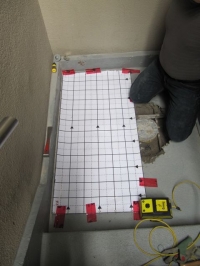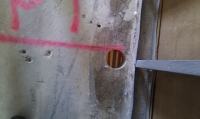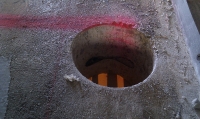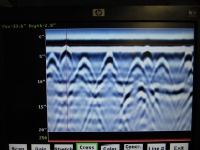Concrete Imaging now provides sub-surface concrete imaging using Ground Penetrating Radar.
 Ground Penetrating Radar, GPR, is the latest state of the art electronic equipment used to locate conduit, rebar and post tension cables. GPR is similar to ultrasound except that ultrasonic devices such as fish finders use acoustic energy where radar uses a radio signal.
Ground Penetrating Radar, GPR, is the latest state of the art electronic equipment used to locate conduit, rebar and post tension cables. GPR is similar to ultrasound except that ultrasonic devices such as fish finders use acoustic energy where radar uses a radio signal.
Gamma-Tech has performed concrete scans in various areas of central Alberta that include renovation, restoration, and construction projects. This technology both supplements and can replace radiographic inspection of concrete for the location of conduits, rebar, and other structures in certain applications.
The success rate of ground penetrating radar technology, procedures, and expertise has been phenomenal. The technicians are dedicated to learning and using radar daily, and our equipment is upgraded as the science advances.
Ground Penetrating Radar System scans can reach a depth of up to 18″ deep; however, it has been our experience that its actual practical application is a max. of 12″ deep. Beyond 12″ deep, it is highly recommended to also scan from the other side.
We can provide all scanning views in either paper copy or electronic format in both two and three dimensions. In small areas where complex or crowded targets are identified we can generate images 1/4 inch slices to a depth of 18 inches to improve the identification of materials in the concrete. This is particularly advantageous when it comes to Q-deck.
If required, and if time allows, we can even view 3D results on screen while on the project.
 |
 |
 |
Advantages
• has the ability to scan difficult to reach areas when you are trying to locate utilities hundreds of square feet can be scanned each day.
• GPR provides concrete images on-the-spot in minutes, before cutting or drilling.
• can provides depth of indications
• can be performed during times of high volumes of personnel as evacuation is not necessary (as with radiography)
• can be very cost effective, especially if client is only putting in inserts
• only method available for determining indications slab-on-grade where there is only access to one side of slab
• can map rebar patterns
Disadvantages
• indications on screen all look same size, so does not offer actual size analysis (this is inherent to the machine)
• if concrete has a layer of Styrofoam in between, scanning will have to be performed from both sides, as it will not go through this
• concrete must have been cured for at least 3 weeks as the moisture in the concrete will make machine have inaccurate readings
• has difficulty finding plastic conduit which does not have power running through it.
• unless conduit is aluminum, they are very difficult to detect unless power is being drawn through it at time of inspection
• cannot detect data lines
• surfaces must be relatively smooth and clean
• machine cannot scan closer than 6″ to a wall or obstruction
• will give erroneous readings when scanning over concrete which is made with small metal filings
